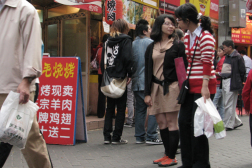
The Past, The Forgotten Time: A Critical Approach to Indonesian History
The exhibition The Past, The Forgotten Time was shown in Jakarta in August, following that it was hosted by a space in Semarang in September. The exhibition then visited Shanghai, from October 25th to November 11th, 2007. The Past, The Forgotten Time was held at Biz-Art, a non-commercial art organization in Shanghai, China.
This exhibition was the final product of the exhibition series Masa Lalu Masa Lupa, which was held by Cemeti Art House in 2006. The topic represents efforts to campaign for a more critical approach to history, both as a basis for creating works, as well as an origination of curatorial ideas. The participating artists questioned societies beliefs about anything that has been presented as “true history.”
This exhibition stems from the research program Indonesia Across Orders, involving 13 researchers from Gadjah Mada University, who went into in depth analysis of the Netherlands Institute for War Documentation. The research provides new insights into the consequences of war, revolution and decolonization for the different population groups in Indonesia from the 1930’s to 1960’s.
We invited Agus Suwage, Eko Nugroho, Irwan Ahmett, Prilla Tania, Wimo Ambala Bayang and Yuli Prayitno to discuss and communicate with the researchers, exchange data and collaborate on ideas. The artists also conducted research on the historical sites referred to in colonial papers and examined the relationship between past events with what is happening in present day Indonesia.
This exhibition represents a variety of perspectives, focusing on the struggle of “becoming Indonesia.” Personal stories, mixed with formal facts, indicate how the colonial situation became a major part in the attempt to formulate an Indonesian identity. Beginning with the visual forms produced by these artists, we learn to remember and reflect on the past, and together, oppose the natural disposition of society to forget.
Not only were the works of the six aforementioned artists exhibited, but the curator of the exhibition, Alia Swastika, and one of the artists (Yuli Prayitno) participated in a brief one month long residency in Shanghai. In addition to assuming responsibility for the exhibition display and organization, they also had the opportunity to conduct research and observe the art community in Shanghai. Although Shanghai is not as popular as Beijing in the development of the arts, there are many interesting museums and galleries to visit in Shanghai.
Alia Swastika and Yuli Prayitno also scheduled meetings with curators, artists and craftmen/craftwomen living in the city. They made presentations and met with students at art academies in Shanghai. It is hoped that a continous dialogue and exchange between Indonesian and Chinese artists, albeit within a limited time frame, can be maintained to optimalize cooperation in the future.

